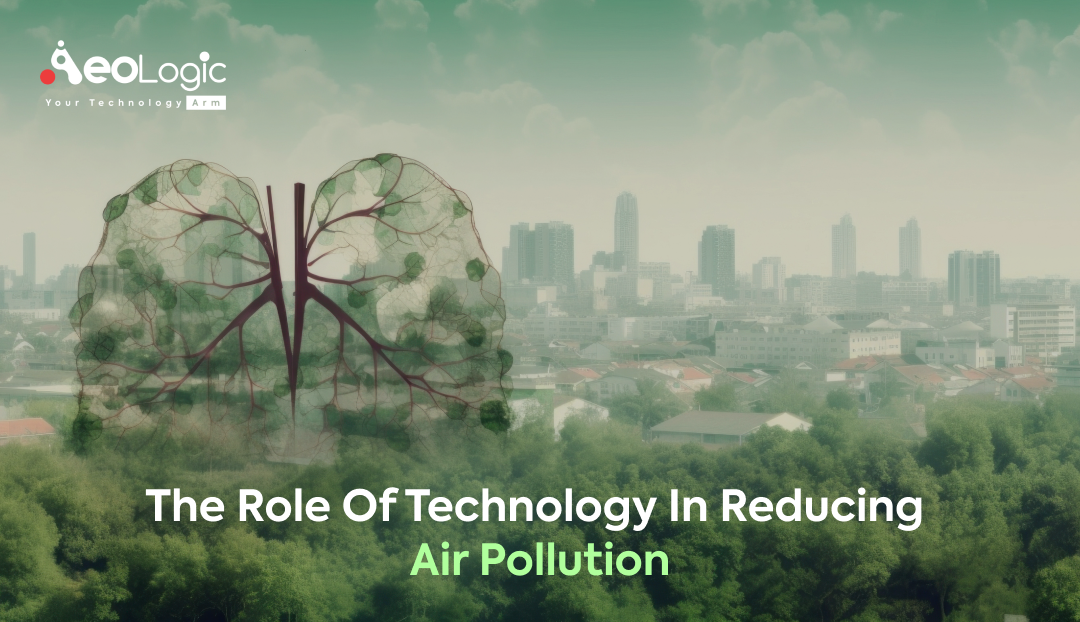Air pollution affects all of us. It sounds like a life assassin striking at our health and ecosystem. But, there’s good news! Moreover, technology is also one of our main ally in reducing air pollution. How Technology Is (and Isn’t) Making It Easier for Us to Breath Clean Air. So How have these Innovations Worked?
Key Highlights Role of Technology in Reducing Air Pollution
- Technological Innovations in Industry and Transportation: Cleaner, efficient technologies in industries and development of electric and environmentally friendly cars.
- Smart Cities and Renewable Energy: Smart city technologies application for pollution monitoring, and green energy alternatives such as solar and wind.
- Public Awareness and Global Collaboration: Improved public awareness of technology and intergovernmental cooperation in dealing with air pollution.
- Future Prospects and Individual Contributions: Further advances in air purification technologies and renewable energies, as well as what each one of us can do to minimize air pollution.
Overall, the article emphasizes the significant role of technology in mitigating air pollution and the combined efforts needed at both the individual and global levels.
Also Read: Emerging Technology Solutions That Accelerate Innovation
Understanding Air Pollution
However, before we explore role of technology in reducing air pollution, let’s understand what it is. To put it plainly, air pollution refers to the existence of dangerous elements in the atmosphere that are harmful to human health and other green beings. These may be gases, particles or biological molecules. Now, let us see the reduction of these pollutants by use of technology.
How can Technology Help To Reduce Air Pollution?
Are you curious about the role of technology in reducing air pollution? Let’s explore the different ways in which innovative technologies are making our air cleaner and our world greener.
Innovative Air Purification Solutions
Technology is fighting air pollution in forms such as air purification. It is possible to purify the air from pollutants such as dust, smoke, and dangerous gaseous substances through advanced air purifiers. Some of these devices depend on filters and other technologies to purify air for use in homes, offices or even outdoor environments. With these purifiers, you can cut the amount of air pollution that gets to your lungs every day.
Renewable Energy Sources
Technology in air pollution reduction takes a major step with the switch to renewable energy. Instead of fossil energy there is a solar energy, wind turbines and hydropower. The fact that such renewable sources do not emit any fumes or gases into the air forms a big step to bringing down air pollution. Additionally, this switch eliminates air pollution from the environment and helps in battling climate changes hence leading to a healthy planet.
- Solar Power Growth: Expansion of solar energy installations.
- Wind Energy Development: Progress in Wind Energy Technology.
- Hydropower: Clean Power from water sources.
- Geothermal Energy: A case study of geothermal energy projects in Kenya.
- Energy Storage Solutions: The development of technologies for storing renewable energy for delivery on demand.
Learn about New Tech Updates: How Spatial Computing is Changing the Way We Live and Work
Electric Vehicles (EVs)
The fight against air pollution has since taken another turn through development of electric vehicles. EVs on the other hand do not have emissions because they are electric based unlike the idling of fossil fueled cars. The more people that convert to EVs makes for less pollution on the road. This should teach you why dense smoke shoaled be turned in for clear air in our cities.
Smart City Solutions
Air pollution is reduced in smart cities by use of technology to better their lives. They use these sensors to sense the quality of air and systems for traffic management that would help in reducing congestion. The reduced traffic decreases the level of the emissions produced and this resulting in cleaner air. Public transportation and cycling are also promoted in smart cities which minimizes pollution.
- Air Quality Sensors: Installation of sensors for live pollution information.
- Data-Driven Policies: Data Analytics for Better Urban Planning.
- Traffic Flow Optimization: Smart Traffic Control to Cut Congestion, Emissions.
- Green Urban Spaces: Plants as air purifiers in city landscapes.
- Citizen Engagement Apps: Public Awareness for Monitoring and Reporting on Pollution.
Industrial Emission Control
Technology has a part to play in the already much appreciated decline of air pollution due industries. The new technology helps the industries to decrease emissions by better manufacturing processes, and hence there is also capacity of pollution control equipment. This involves the use of filters and scrubbers that reduce industrial emissions before they are released into the air. Industries could then use these technologies and help to lower their pollution footprint considerably.
- Emission Control Systems: The Installing of Filters and Scrubbers in Factories.
- Energy Efficiency: Energy-Saving Technologies in Manufacturing Processes.
- Sustainable Materials: Production using environmental friendly materials.
- Waste Management Technologies: Sophisticated Approaches to the Reduction of Industrial Waste.
- Green Certifications: Promoting environmental compliance by industries.
Monitoring and Predicting Air Quality
Monitoring and Predicting Air Quality Are Vital Uses of Technology. Today, we have sensors and satellites that are much more sophisticated to record the extent of pollution as it occurs. It is important to note that the information is very useful in decision making about reducing exposure to polluted air. Additionally, predictive models can assist in the prediction of future patterns of pollution making potential steps before time.
Agricultural Innovations
Agriculture is also implicated in air pollution, a challenge that new technology has helped to curb. Farmers are able to utilize fertilizers more effectively to help reduce emissions from using precision agriculture tools. In addition, technology also facilitates more efficient management of livestock waste that is a major cause of air pollution in rural areas.
Advancements in Transportation
Air pollution is also resulted from this exhaust of fumes from vehicles constitutes another major source. However, technology makes vehicles more environmentally sound. There is an increased popularity of electric cars that use no emissive gas. Clean Technology Upgrades are also Underway in Public Transportation. This is an important move towards reducing pollution that would be caused by millions of vehicles on the road every day.
- Electric Vehicles (EVs): Growing Adoption and Advances of EVs.
- Public Transit Upgrades: Adoption of Cleaner, More Efficient Transit Systems.
- Cycling and Walking Infrastructure: Promoting non-motorized transport options.
- Smart Traffic Management: Leveraging Technology to Reduce Congestion and Emissions+.
- Biofuels and Alternative Energy: Searching for the New New Fuel to Power Up Traditional Vehicles.
Also Read: How to Choose the Right Tailored Technology Solutions for Your Needs
App and Tools to Empower Individuals
During this current digital era, apps and tools enable you to do zome good to the air quality. There are many smartphone apps, which monitor your carbon footprint, recommend the most eco-friendly travelling routes and even assist you in adopting sustainable lifestyles. Using these tools helps you to be a part of solution in the fight against air pollution in your everyday life. It is unbelievable how a few pokes in your phone would help you have a healthier planet.
- Get air quality monitoring apps for download and use.
- Use of carbon footprint calculators for personal impact.
- Green navigation apps guide to eco-friendly route choices.
- Use of social media in catalyzing community-based environmental initiative.
- We can also engage in online forums and write blogs to shared their knowledge on sustainability.
Green Building Technologies
The buildings we live and work in contribute significantly to air pollution, but technology is changing this narrative. Green building technologies, like energy-efficient heating systems and smart thermostats, reduce energy consumption and emissions. These technologies not only make buildings more environmentally friendly but also improve indoor air quality, creating healthier spaces for us to inhabit.
- Implement smart thermostats for energy-efficient heating and cooling.
- Use low-emission building materials in construction.
- Install solar panels for renewable energy sourcing.
- Implement green roofs and walls to improve air quality and insulation.
- Adopt smart lighting systems to reduce electricity consumption.
Waste Management Innovations
Effective waste management is crucial in reducing air pollution. Technological advancements in this sector include waste-to-energy processes and advanced recycling techniques. By efficiently managing waste, we reduce landfill emissions and the burning of waste, which are major sources of air pollution. As these technologies become more widespread, they play a pivotal role in maintaining cleaner air.
- Develop and utilize waste-to-energy technologies.
- Enhance recycling processes with advanced sorting technology.
- Implement composting programs to reduce organic waste.
- Utilize biodegradable materials to minimize landfill emissions.
- Adopt community-based programs for effective waste reduction and management.
Role of AI and Machine Learning
Artificial Intelligence (AI) and Machine Learning are at the forefront of tackling air pollution. These technologies analyze vast amounts of environmental data to predict pollution patterns and suggest effective solutions. For instance, AI can optimize traffic flow in cities to reduce vehicle emissions or help industries minimize their environmental impact. The potential of AI in this field is vast and continually evolving.
- Use AI to predict and manage urban air pollution levels.
- Implement machine learning for traffic management to reduce emissions.
- Develop AI-based systems for real-time monitoring of industrial emissions.
- Utilize AI in predicting weather patterns related to air quality.
- Integrate AI in the design of eco-friendly products and services.
Also Read: Air Cargo Solutions for Airline Cargo Management
Final Thoughts
The role of technology in reducing air pollution is multifaceted and continuously evolving. From the industry to our homes, technology offers solutions that are changing the way we interact with our environment. By embracing these technologies and supporting sustainable practices, we can all play a part in this global effort to breathe cleaner air.






